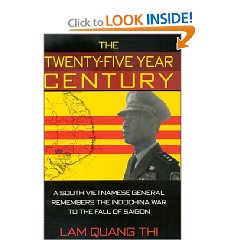
Sadly, the book, while full of extraordinary detail at a personal level, is extremely tedious. It *felt* like it took a century to read, and my eyes just glazed over with page after page of names of relatives, classmates, town, etcetera.
The author's first book, Autopsy: The Death of South Viet Nam is probably a much better book for anyone other than a student of the genealogical details.
The photos were disappointing, and while the strategic maps were helpful there was little to enliven the thirteen chapters.
Over-all I formed three impressions:
1) The author was an extraordinary mix of Chinese and Vietnamese, French-educated, and Cao Dai/Catholic in family heritage. He acquired the viewpoints inherent in the French and the Catholic, and strongly perceives Ho Chi Minh to have been a communist puppet of Moscow, and not at all a nationalist. Th
2) The author considers the US to have betrayed South Viet-Nam, leading to the loss of a one million man Army and the abandonment of five billion dollars in equipment, all in part because the US media decided the war was lost, and the US public forced the politicians to give up. While I dispute this personally, the view is strongly supported by one of the best revisionist histories I have read, Triumph Forsaken: The Vietnam War, 1954-1965.
3) The author provides excellent context from his point of view on the concurrent ideological splits in Korea, Malaysia, and the Philippines at the time, and articulates his view the Viet-Nam was the place where the burden fell for giving the West time to win the Cold War–1.5 million soldiers and 2 million civilians DIED for that time–the wounded are probably ten times that number. In this regard, there are similarities with the Afghanistan point of view presented in The Main Enemy: The Inside Story of the CIA's Final Showdown with the KGB
For myself, while acknowledging that the book does indeed fill a void and there are too few books written by South Vietnamese leaders of any sort, I personally found the book very tedious and disappointing. It still merits four stars, there is no contesting the utility of the detail and the perspective, but not for me.
Books have are more consistent with my own experience, both as a young man in Viet-Nam and as a recovering spy, include:
Who the Hell Are We Fighting?: The Story of Sam Adams and the Vietnam Intelligence Wars
None So Blind: A Personal Account of the Intelligence Failure in Vietnam
War Without Windows
The Tet Offensive: Intelligence Failure in War (Stemme)
The author slams Robert McNamara for his “lucrative” memoires, presubably referring to both Wilson's Ghost: Reducing the Risk of Conflict, Killing, and Catastrophe in the 21st Century and the DVD The Fog of War – Eleven Lessons from the Life of Robert S. McNamara.
Today we are in Afghanistan and President Obama has fallen prey to the military-industrial complex, which is doing to him what Henry Kissinger did to the American public, killing another 20,000 young men so Richard Nixon could win an election. See The Trial of Henry Kissinger. At Phi Beta Iota, the Public Intelligence Blog, see the Event Report on the Counterinsurgency Conference to understand how nothing has changed in Washington between Viet-Nam and Afghanistan.




